
 |
| @¡Keihoku Course kHosono (starting place) \ Hosono (finishing place), 35.4km, @@Trail Board Number from K1 to K19, 5.5kml |
| @From Hosono to Jyosho-koji Temple (Trail Board Number from No.1 to No.34) |
  |
| Left: Branch point at Todoroki-dani (take the right path to go to Taki-matano-taki Falls Right: Legendary rock cave of Jyukkai-inga-koji |
|
At the junction of three roads of Keihoku Hosono-cho Town, there is an old Hosono Elementary School on the Shuzan-kaido Road. Go through the schoolyard to Yane-bashi Bridge and go along Yamadadani-gawa River. Use a temporary walking path near the entrance of the tunnel as this area is currently under construction for Kurio Bypass. Please open-and-close the chain gate when passing it. Take the right path branched from Yamadadani-gawa River to Todoroki-dani Valley. Cross the river several times. Cedar forest changes to broad leaf forest. You will find the rock cave on the upper side of the left bank in which Jyukkai-inga-koji allegedly lived secretly. He was a famous monk for "Azuchi religious dispute" and is said to be a nephew of Nobunaga Oda. |
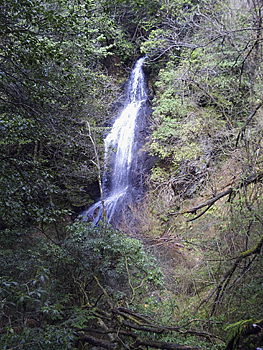 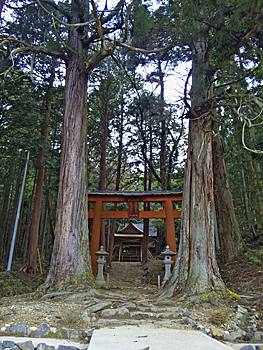 |
| Left: Taki-matano-taki Falls Right: Kuzu-jinjya Shrine in Yono |
|
After passing the area of wide flat rocks in the mountain stream and the rocky area on the right bank, you will reach Taki-matano-taki Falls with a drop of 20-meter. This is a popular sightseeing spot.Go back to the rocky area and go up the right side of the bank to the upper side of the fall. The slope of the valley becomes slow in cedar forest. You may see local people polishing wrinkle-processed surfaces of Kitayama cedar logs. You will reach Yono after going through several small mountain passes. You will reach Kuzu-jinjya Shrine in a village in a small basin. There is a big cedar stump in the shrine yard. The Haiden (a hall of worship) with beautiful carvings and chidori hafu (triangular shaped gable) is covered by a big roof. This shrine built in 1778 was designated as a registered cultural property by Kyoto City. |
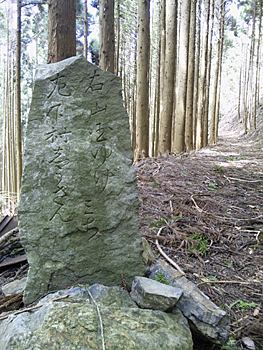 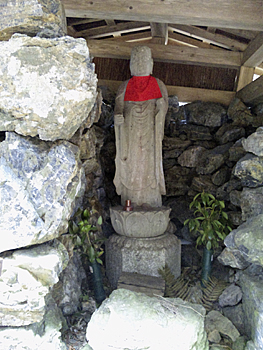 |
| Left: Stone marker at Chanomi-toge Pass (It has the inscription of "the right path goes to Yuge, Yamaguni") Right: Stone image of Bosatsu (bodhisattva) at Chanomi-toge Pass |
|
Soon after entering the village of Yono, turn to the left and pass through upstream of Fushimizaka to go to Oomori-nishi-cho. There stretches out well pruned woodlots around here. From Oomori, go up to Chanomi-toge Pass through Nishino-tani which locates upstream of Kiyotaki-gawa River. There is a big stone image statue of the Jizo-bosatsu (bodhisattva) in a stone-lined small shrine on the pass. The left path goes to Shimo-machi, Shuzan (Kamochi-dani Valley, Inaridani-gawa River). But, take the right path if you go on the Trail Course. |
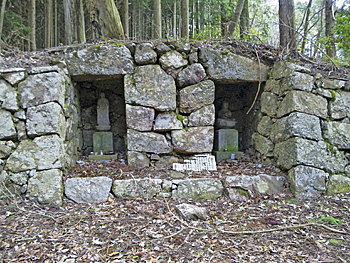 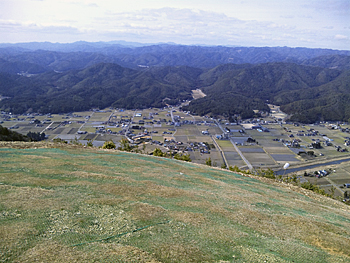 |
| Left: Two stone Buddhist images at Tatsuga-saka Right: The view from the paragliding take-off site |
|
From here, a typical pass road goes northwest to Tatsugasaka Pass through the remains of Narunodo Hall along about the same contour. The path transversely goes on a hillside is called "Yuri" in Japanese. There are some proper names with "Yuri" in Kitayama area like Ninose-yuri. You can take a view of mountains of Mt. Jizo-yama, Mt. Ryuga-take and Mt.
Atago-yama from just before the pass. Go up to the east along the ridge from Tatsugasaka, you will reach a paragliding take-off site of which north side has open view. Enjoy the best view in this course (it takes about 25 minutes there and back). Also, recently new course to Mt. Tendo-san situated on Jyotan-kokkyo-one Ridge was opened. The ridge stretches further east to Mt. Iimori-yama and Mt. Sajiki-gatake. This ridge is the divide between Kamo-gawa River system and Katsura-gawa River system.After praying to Dainichi Nyorai (Mahavairocana) and Jizo Bosatsu (Jizo Bodhisattva) in the sturdy stone hut, go down to Nakae. You will find many grafted cedars and also an old manganese mining area. Soon after seeing the torii (shrine gate) of Kamo-jinjya Shrine enshrining Kamowakeikazuchi no ohkami and Tanba style houses, you will reach Nakae. On the other side of Kamikatsura-gawa River, you will see Mt. Kokino-san, also known as Mt. Yamaguni-Fuji (Mt. Fuji in Yamaguni). |
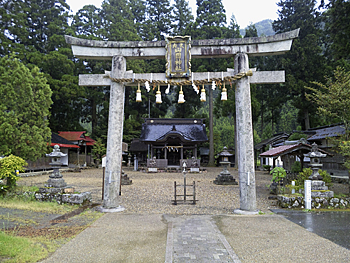 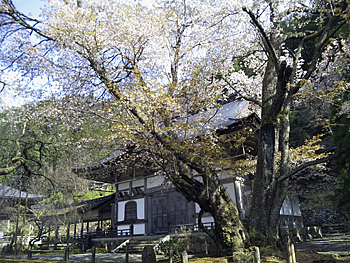 |
| Left: Yamaguni-jinjya Shrine. Right: Jyosho-koji Temple |
|
Go up on the left bank of Kamikatsura-gawa River and cross Kamenoko-bashi Bridge at the end of the ridge where the old Nakae-jyo Castle used to stand. The Kinki-shizen-hodo (natural trail) runs through on the right bank. If you go downstream toward the shrine gate, you can visit Yamaguni-jinjya Shrine. The imperial troop Yamagunitai gathered at this shrine and vowed to fight for the Emperor at the time of the Meiji Restoration. The figures representing the Yamagunitai led the parade of the Kyoto Jidai Matsuri (Kyoto's Festival of the Ages) for years and also can be seen in the processions at the Yamaguni Festival in every October. At the crossing point with Route 477, there is Rokkaizeki-weir. This is an intake weir for irrigation water led to the scattering villages along the river (Higae, Nakae, To, Tsuji, Torii and Shimo). The rush of water is running into the irrigation ditches from the weir built over the breadth of the river. After passing Nogami-bashi Bridge and Kumano-jinjya Shrine, take the right bank path from the near side of Shinto-bashi Bridge. This is called the Old Kogon Path. Walk carefully on rocks and in cedar forest. Soon after seeing Sanryo-bashi Bridge, you will reach the approach to Josho-koji Temple (Daiyumeizan-manjyu-jyosho-koji Temple). This is an old temple founded by Emperor Kogen in 1362. Go up to the north along the path lined with cherry trees to the temple gate. There is Chokushi-mon Gate (the gate for the Imperial Envoys) in front of the Chokugaku-mon Gate. Go up the left stone steps to the Kuri (the priest's living quarters or the kitchen of a temple) and the temple ground. In the temple garden facing Hojo (Abbots' Quarters) and Taiun-an, there are famous cherry trees; 'Mikuruma-gaeshi-no-Sakura' (this name comes from the anecdote that Emperor made his carriage come back to view the beautiful blossoms as those were very beautiful) with single and double cherry blossoms in the same branch, Sakon-no-sakura which was multiplied by division from the tree in the Imperial Palace, and Kokonoe-zakura (cherry tree with nine-fold cherry flower, designated as national natural treasure). Also this temple possesses a lot of Buddha statues including Wooden Statue of Amida Nyorai and Two Flanking Attendant Statues (important cultural properties) and Kannon-zo (the image of the Kannon) seated in Japanese style which resembles the image of Sansonbutsu (three Buddhist deities) in Ohara Sanzen-in Temple. |
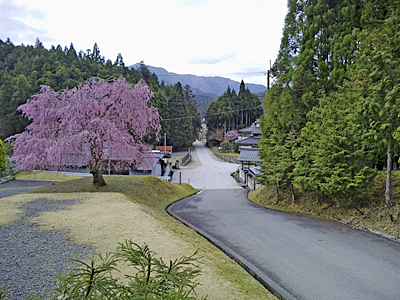 |
| sApproximate time requiredt Hosono (No.1) ( 60min.) Taki-matano-taki Falls (No.4) (50min.) Yono (No.9) (20min.) Fushimi-zaka (No.11) (10min.) Oomori Nishi-machi (No.13) (60min.) Chanomi-toge Pass (No.15) (40min.) Tatsugasaka (No.18) (40min.) Nakae (No.24) (15min.) Kamenoko-bashi Bridge (No.26) (50min.) Sanryo-bashi Bridge (No.34) (10min.) Jyosho-koji Temple |
| ¨ Nishiyama Course (Trail Board Number from 24 to 51j |
| ¨ Keihoku Course (Trail Board Number from K1 to K19 and from No.34 to 68j |
| ¨ High points |
| ¨ Back to the Top of this Page |
| © Kyoto Trail Guide Association |